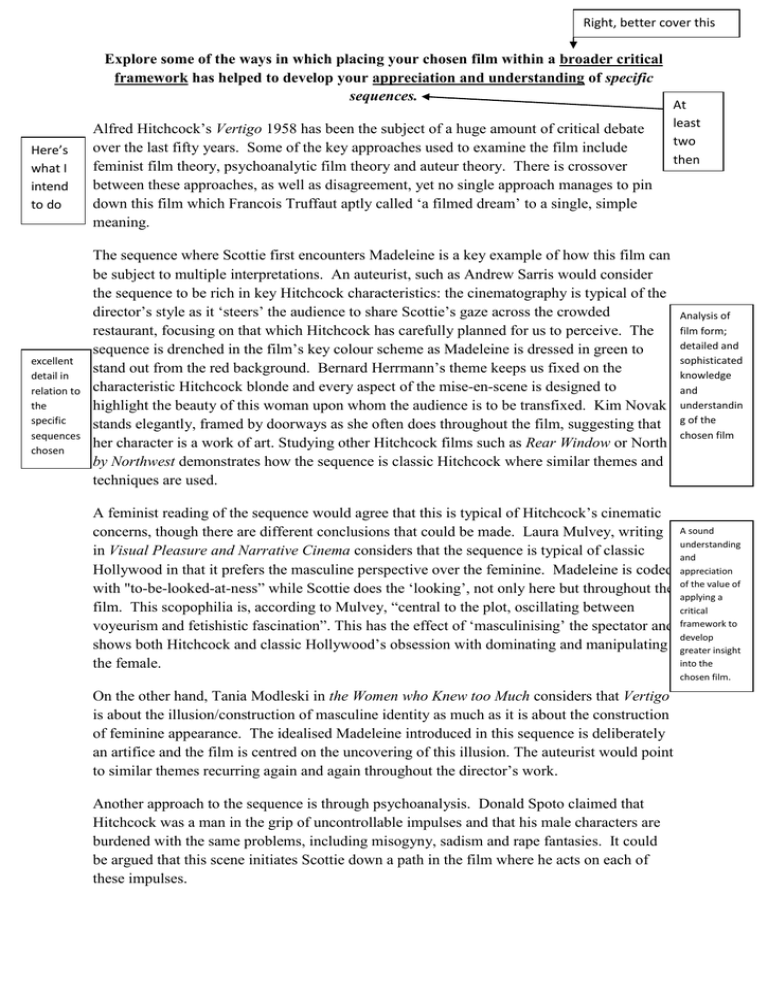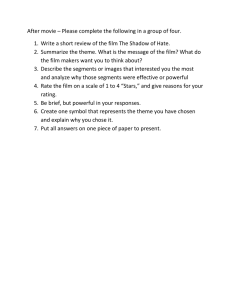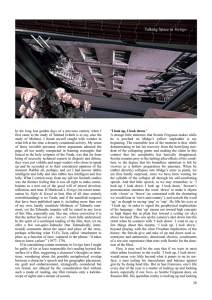At least two then Right, better cover this Explore some of the ways in
advertisement

Right, better cover this Explore some of the ways in which placing your chosen film within a broader critical framework has helped to develop your appreciation and understanding of specific sequences. Here’s what I intend to do excellent detail in relation to the specific sequences chosen Alfred Hitchcock’s Vertigo 1958 has been the subject of a huge amount of critical debate over the last fifty years. Some of the key approaches used to examine the film include feminist film theory, psychoanalytic film theory and auteur theory. There is crossover between these approaches, as well as disagreement, yet no single approach manages to pin down this film which Francois Truffaut aptly called ‘a filmed dream’ to a single, simple meaning. At least two then The sequence where Scottie first encounters Madeleine is a key example of how this film can be subject to multiple interpretations. An auteurist, such as Andrew Sarris would consider the sequence to be rich in key Hitchcock characteristics: the cinematography is typical of the director’s style as it ‘steers’ the audience to share Scottie’s gaze across the crowded restaurant, focusing on that which Hitchcock has carefully planned for us to perceive. The sequence is drenched in the film’s key colour scheme as Madeleine is dressed in green to stand out from the red background. Bernard Herrmann’s theme keeps us fixed on the characteristic Hitchcock blonde and every aspect of the mise-en-scene is designed to highlight the beauty of this woman upon whom the audience is to be transfixed. Kim Novak stands elegantly, framed by doorways as she often does throughout the film, suggesting that her character is a work of art. Studying other Hitchcock films such as Rear Window or North by Northwest demonstrates how the sequence is classic Hitchcock where similar themes and techniques are used. A feminist reading of the sequence would agree that this is typical of Hitchcock’s cinematic concerns, though there are different conclusions that could be made. Laura Mulvey, writing in Visual Pleasure and Narrative Cinema considers that the sequence is typical of classic Hollywood in that it prefers the masculine perspective over the feminine. Madeleine is coded with "to-be-looked-at-ness” while Scottie does the ‘looking’, not only here but throughout the film. This scopophilia is, according to Mulvey, “central to the plot, oscillating between voyeurism and fetishistic fascination”. This has the effect of ‘masculinising’ the spectator and shows both Hitchcock and classic Hollywood’s obsession with dominating and manipulating the female. On the other hand, Tania Modleski in the Women who Knew too Much considers that Vertigo is about the illusion/construction of masculine identity as much as it is about the construction of feminine appearance. The idealised Madeleine introduced in this sequence is deliberately an artifice and the film is centred on the uncovering of this illusion. The auteurist would point to similar themes recurring again and again throughout the director’s work. Another approach to the sequence is through psychoanalysis. Donald Spoto claimed that Hitchcock was a man in the grip of uncontrollable impulses and that his male characters are burdened with the same problems, including misogyny, sadism and rape fantasies. It could be argued that this scene initiates Scottie down a path in the film where he acts on each of these impulses. Analysis of film form; detailed and sophisticated knowledge and understandin g of the chosen film A sound understanding and appreciation of the value of applying a critical framework to develop greater insight into the chosen film. Conversely, J. L. Baudry suggests that Hitchcock, as an auteur would be aware that that the cinema situation reproduces the hallucinatory power of a dream because it turns perception into something that looks like a hallucination, except "film offers an artificial psychosis without offering the dreamer the possibility of exercising any kind of immediate control." Hitchcock merely plays with perception in this sequence. Perhaps it is not Hitchcock’s impulses, but our own that the film explores. Again, these are themes that dominate the Hitchcock canon. Certainly, this is one of the most complex scenes in the film and takes on multiple meanings from a second viewing onward, developing understanding and appreciation. Another sequence that reveals complexities through applying critical approaches is… characterised by a particular command of the critical framework and their work will reveal particular and striking insights into the chosen film.







